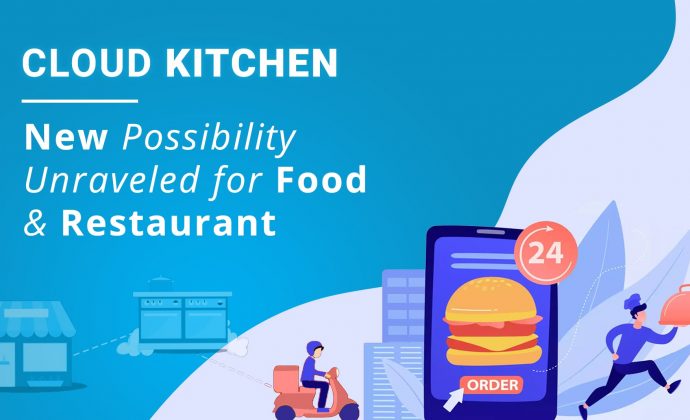The food industry has gone through a lot of changes in the past few years, thanks to the rapid growth in technology, ever-rising startup cost, and a global pandemic. Restaurants, eateries, cafes, hotels, and other hospitality sectors are looking to implement new ways to serve their customers while keeping the business afloat. Most of these steps are aimed at providing convenience and making food easily accessible to everyone.
Online food ordering has already taken its roots in the society and the indefinite era of the pandemic only served to make it more viable. In such scenarios, the food industry has come up with a new concept, or rather a new development on an old concept which has come to be known as Cloud Kitchen.
A cloud kitchen, also referred to as ghost kitchen or virtual kitchen, is a commercial facility that is specifically used to prepare food for deliveries and takeouts. The entire model of the ghost kitchen is based on a delivery-only service, which provides ghost kitchens with a few advantages over traditional brick-and-mortar restaurants doing deliveries.
How does a Cloud Kitchen Work?
Now that we have cleared that a cloud kitchen is essentially a delivery-only restaurant that does not have any physical space to offer dine-in service. The restaurant relies entirely on online orders placed through the restaurant’s website/app or a food aggregator.
The cloud kitchen model also allows restaurants to launch more than one brand using the same kitchen premises. For instance, a restaurant that employs a delivery-only kitchen to deliver Asian food can use the same kitchen to deliver mexican food. But instead of incorporating the Mexican food in the same brand, it can launch another brand entirely for Mexican food only.
Most often than not, cloud kitchens are situated in outskirts, industrial areas and offer driver parking, driver waiting areas, and check-in stations to allow seamless driver pick-up. The most important aspect of cloud kitchen is the technology that goes behind it. These facilities use large amounts of data to determine what types of food are in demand in specific locations and employ popular delivery apps to make deliveries.
Taking orders in a Cloud Kitchen
Most of the orders for a cloud kitchen restaurant come from online, which makes a POS mandatory for these particular models of restaurants. A cloud kitchen restaurant can take orders from multiple platforms including food aggregator’s apps, website/app, and telephone.
Getting orders from different platforms makes order management a daunting task, which is why a POS is required for a cloud kitchen restaurant. A proper POS in place makes it easier to handle orders and maintain a consistent delivery process.
Moreover, POS is also essential for cloud kitchen restaurants that deliver food under multiple brands so the detailed insights and data about numbers of orders received for each brand remains in place and accessible.
Order Processing in a Cloud Kitchen
In terms of order processing, cloud kitchen restaurants work similarly to any other restaurant. Nevertheless, when multiple brands are operated under one cloud kitchen, it is imperative to watch out that the distinct taste of each brand is maintained. Most cloud kitchens employ various cooks in order to make sure the unique taste for each brand is maintained.
Once again, a proper POS system in place can help smoothen the order processing procedure. A POS system reflects orders directly to the kitchen screen as soon as an order is accepted on the website or app. Once the order is prepared, the kitchen staff can mark it ‘done’ on the kitchen display and the packaging process is cued in. The packaging staff packs the items and sends it to the delivery station while the POS records each of these steps to help you analyse and optimise the order processing time and procedure.
Managing Staff in a Cloud Kitchen
A cloud kitchen restaurant does not have any physical premise to let people dine-in, which means such facilities do not require much in terms of staff. However, the lack of wait staff has to be reciprocated with excellent kitchen staff as the taste the restaurant offers will be one of its main selling points.
Most cloud kitchens hire different chefs to handle each brand they are operating under the roof. Besides kitchen staff, delivery executives are needed, if the restaurant relies on an in-house ordering system.
Managing Inventory and Suppliers in Cloud Kitchen
Finalizing and maintaining suppliers in a cloud kitchen is similar to the regular, commercial restaurant kitchen. Restaurants operating various brands with the same basic ingredient requirement under one cloud kitchen can order basic ingredients from the same supplier and different ingredients from various suppliers.
If the supplier provides a diverse range of ingredients, all the brands’ essentials can be supplied from one source. Before finalizing a supplier, it is advised to create a list of ingredients that the brands require and try to order most of them from one place. It will help you keep track of the suppliers and inventory.
In terms of inventory management, most cloud kitchens use a smart POS to conveniently control various aspects of inventory and stock. A POS allows cloud kitchens to manage daily consumption and different brand requirements from a single screen.
Marketing a Cloud Kitchen
The marketing needs of cloud kitchens are very different than that of regular restaurants, given that the former does not have any physical outlet. Without a premise where customers can walk in to dine, the need for powerful social marketing and branding arises. As a cloud kitchen owner, you need to be able to do online marketing using social media platforms, SMS and email marketing, brochures and flyers, and integrating third-party delivery apps, and tying up with complimentary restaurants.
Proper use of technology and is essential for a cloud kitchen to thrive so make sure you are making the best use of the technology at-hand including POS, social media platforms, mobile marketing, and properly targeting your audience.


